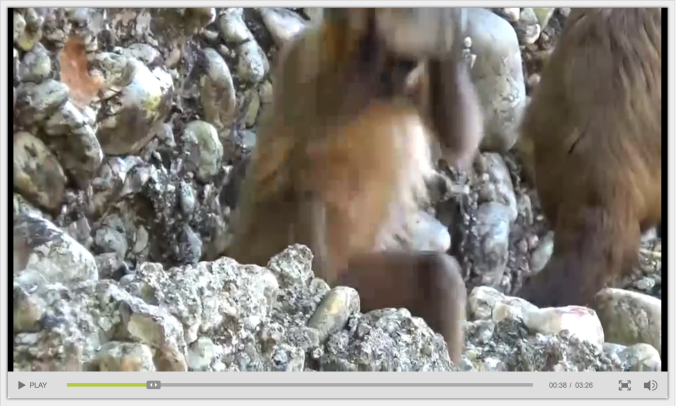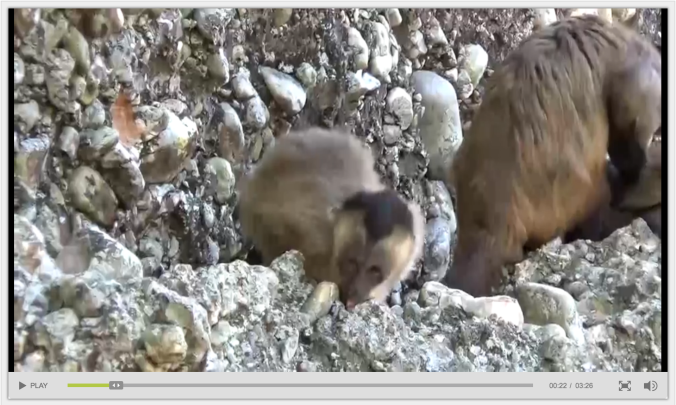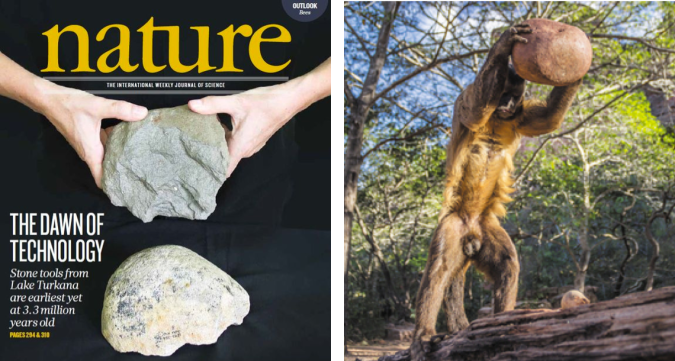A month ago at ESHE and now online in Nature, Proffitt and colleagues describe stone-on-stone smashing behavior among wild bearded capuchin monkeys (Sapajus libidinosus). The online paper includes a great video documenting the action; here’s a screenshot:

Holding the rock with both hands just above head-level, the monkey prepares to crush its enemies. Which in this case are another rock stuck in a pile of more rocks.
In the fairly rare cases where non-human primates use stones, it’s for smashing nuts or something. But when these capuchins see a stone they don’t just see a smasher, they see a world of possibilities* – why use a rock to break a rock, when you could use it to break a heart? So this group of capuchins is unique in part because they’ve been documented to use stones for many purposes.
Now why on earth a monkey would use one rock to break another rock is anyone’s guess. In human evolution, the purpose was to break off small, sharp flakes that could be used to butcher animals or work plants. Proffitt et al. did observe small flakes being removed when capuchins pounded rocks, but the monkeys showed little interest in this debitage, other than using it to continue smashing stuff. More curiously, the monkeys frequently lick the rock after hammering at it:

Mmm, rocks.
Proffitt et al. venture that maybe these monkeys are doing this to ingest lichens or trace elements like silicon. This hypothesis merits further investigation, but what’s clear is that these monkeys’ lithics differ from the hominin archaeological record wherein the express purpose of breaking rocks is to make flakes.
What’s striking to me (pun intended) is the relative size of the rocks. These monkeys that weigh only 2-3 kg are lifting and smashing stones that weigh about half a kilogram on average. Because these stones are fairly large given the monkeys’ body size, they have to be lifted with two hands and brought down on a surface, a “passive hammer” technique. The earliest-known tools made by hominins, from the 3.3 million year old Lomekwi site in Kenya, are also pretty big. Weighing 3 kg on average but topping at 15 kg, these earliest tools would have required the same knapping technique as is used by these little monkeys (Harmand et al., 2015).

Left: Cover of Nature vol. 521 (7552). Right: Bearded capuchin letting a pebble know who’s boss (link).
Why the big stuff at first? Did the earliest hominin tool-makers lack the dexterity to make tools from the smaller rocks comprising the later Oldowan industry? These creative capuchins could lead to predictions about the hand/arm skeleton of the Lomekwian tool-makers (testable, of course, only with fortuitous fossil discoveries). Capuchins are noted for their manual dexterity (Truppa et al., 2016) and have a similar thumb-index finger ratio to humans and early hominins (Feix et al. 2015), although they differ from humans in the insertion of the opponens muscle and resultant mobility of the thumb (Aversi-Ferreira et al., 2014). Maybe these tech-smart monkeys can tell us more about the earliest human tool-makers’ bodies than their brains.
 References
References
Aversi-Ferreira RA, Souto Maior R, Aziz A, Ziermann JM, Nishijo H, Tomaz C, Tavares MC, & Aversi-Ferreira TA (2014). Anatomical analysis of thumb opponency movement in the capuchin monkey (Sapajus sp). PloS one, 9 (2) PMID: 24498307
Feix T, Kivell TL, Pouydebat E, & Dollar AM (2015). Estimating thumb-index finger precision grip and manipulation potential in extant and fossil primates. Journal of the Royal Society, Interface, 12 (106) PMID: 25878134
Harmand S, Lewis JE, Feibel CS, Lepre CJ, Prat S, Lenoble A, Boës X, Quinn RL, Brenet M, Arroyo A, Taylor N, Clément S, Daver G, Brugal JP, Leakey L, Mortlock RA, Wright JD, Lokorodi S, Kirwa C, Kent DV, & Roche H (2015). 3.3-million-year-old stone tools from Lomekwi 3, West Turkana, Kenya. Nature, 521 (7552), 310-5 PMID: 25993961
Proffitt, T., Luncz, L., Falótico, T., Ottoni, E., de la Torre, I., & Haslam, M. (2016). Wild monkeys flake stone tools Nature DOI: 10.1038/nature20112
Truppa V, Spinozzi G, Laganà T, Piano Mortari E, & Sabbatini G (2016). Versatile grasping ability in power-grip actions by tufted capuchin monkeys (Sapajus spp.). American Journal of Physical Anthropology, 159 (1), 63-72 PMID: 26301957
*well, at least four uses given by Proffitt et al.: mating display, aggression, food-crushing, and digging.
Pingback: Worst year in review | Lawn Chair Anthropology